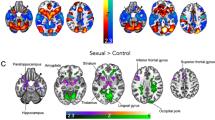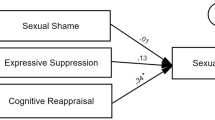Abstract
Hypoactive Sexual Desire Dysfunction (HSDD) in women has a complex origin, and addressing modifiable factors can lead to the best outcomes. One contributing factor is sexual boredom, particularly in women in monogamous relationships and we decided to evaluate sexual novelty as a therapeutic strategy in such women using prospective randomized study design. These women were recruited following screening using a Decreased Sexual Desire Screener (DSDS). Participants’ baseline sexual boredom was assessed using the Sexual Boredom Scale (SBS). Reasons for sexual boredom were identified, and customized novelty packages were developed accordingly. The participants were divided into two groups: Group A received psychotherapy alone (n = 196), while Group B (n = 202) received psychotherapy along with a customized sexual novelty package. Sexual desire levels were measured and compared at baseline and after a six-month intervention using the Elements of Desire Questionnaire (EDQ). The groups were similar in age, duration of monogamy, SBS scores, and baseline EDQ scores. Post-intervention results showed that the improvement in EDQ scores for the sexual novelty group was double that of the psychotherapy group (1.8 ± 0.3 vs 0.9 ± 0.1, p < 0.0001). Moreover, multiple regression models showed that lower age of the participant (p = 0.0253) and a longer period of monogamy (p = 0.0268) adversely affected sexual desire.
This is a preview of subscription content, access via your institution
Access options
Subscribe to this journal
Receive 12 print issues and online access
$259.00 per year
only $21.58 per issue
Buy this article
- Purchase on SpringerLink
- Instant access to full article PDF
Prices may be subject to local taxes which are calculated during checkout



Similar content being viewed by others
Data availability
The datasets generated and analysed in the current study are available from the corresponding author upon reasonable request.
References
World Health Organization. 11th revision of the International Classification of Diseases,. Avaialble at: https://icd.who.int/browse11/l-m/en#/http%3a%2f%2fid.who.int%2ficd%2fentity%2f1189253773 Published 2019. Accessed Frbruary 13, 2023.
Rosen RC. Prevalence and risk factors of sexual dysfunction in men and women. Curr Psychiatry Rep. 2000;2:189–95.
Parish SJ, Goldstein AT, Goldstein SW, Goldstein I, Pfaus J, Clayton AH, et al. Toward a more evidence-based nosology and nomenclature for female sexual Dysfunctions-Part II. J Sex Med. 2016;13:1888–906.
Clayton AH, Goldstein I, Kim NN, Althof SE, Faubion SS, Faught BM, et al. The International society for the study of women’s sexual health process of care for management of hypoactive sexual desire disorder in women. Mayo Clin Proc. 2018;93:467–87.
Graziottin A, Maseroli E, Vignozzi L Female Sexual Dysfunctions: A Clinical Perspective on HSDD, FAD, PGAD, and FOD. In: Bettocchi, C, Busetto, GM, Carrieri, G, Cormio, L (eds) Practical Clinical Andrology. Cham: Springer; 2023. https://doi.org/10.1007/978-3-031-11701-5_8
Pachano Pesantez GS, Clayton AH. Treatment of hypoactive sexual desire disorder among women: general considerations and pharmacological options. Focus (Am Psychiatr Publ). 2021;19:39–45. https://doi.org/10.1176/appi.focus.20200039
Kingsberg SA. Attitudinal survey of women living with low sexual desire. J Womens Health (Larchmt). 2014;23:817–23. https://doi.org/10.1089/jwh.2014.4743
Klusmann D. Sexual motivation and the duration of partnership. Arch Sex Behav. 2002;31:275–87. https://doi.org/10.1023/a:1015205020769
Bitzer J, Giraldi A, Pfaus J. Sexual desire and hypoactive sexual desire disorder in women. Introduction and overview. Standard operating procedure (SOP Part 1). J Sex Med. 2013;10:36–49. https://doi.org/10.1111/j.1743-6109.2012.02818.x
Rosa MN, Matthews SA, Giuliano TA, Thomas KH, Swift BA, Mills MM. Encouraging erotic variety: Identifying correlates of, and strategies for promoting, sexual novelty in romantic relationships. Pers Individ Dif. 2019;146:158–69.
Watt JD, Ewing JE. Toward the development of a measure of sexual boredom. J Sex Res. 1996;33:57–66.
Tunariu AD, Reavey P. Men in love: Living with sexual boredom. Sex Relationship Ther. 2003;18:63–94.
Clayton AH, Goldfischer ER, Goldstein I, Derogatis L, Lewis-D’Agostino DJ, Pyke R. Validation of the decreased sexual desire screener (DSDS): a brief diagnostic instrument for generalized acquired female hypoactive sexual desire disorder (HSDD). J Sex Med. 2009;6:730–8.
Grover S, Shouan A. Assessment scales for sexual disorders—a review. J Psychosexual Health. 2020;2:121–38. https://doi.org/10.1177/2631831820919581
Revicki DA, Althof SE, Derogatis LR, Kingsberg SA, Wilson H, Sadiq A, et al. Reliability and validity of the elements of desire questionnaire in premenopausal women with hypoactive sexual desire disorder. J Patient Rep Outcomes. 2020;4:82.
Pyke RE, Clayton AH. Assessment of sexual desire for clinical trials of women with hypoactive sexual desire disorder: measures, desire-related behavior, and assessment of clinical significance. Sex Med Rev. 2018;6:367–83.
Pourhoseingholi MA, Vahedi M, Rahimzadeh M. Sample size calculation in medical studies. Gastroenterol Hepatol Bed Bench. 2013;6:14–7.
de Oliveira L, Carvalho J, Nobre P. A systematic review on sexual boredom. J Sex Med. 2021;18:565–81.
Schnarch DM. Passionate marriage: Sex, love, & intimacy in emotionally committed relationships. New York, NY: WW Norton; 2009.
Perel E. Mating in Captivity. London: Yellow Kite Books;2007.
Hardy JW, Easton D. The ethical slut: A practical guide to polyamory, open relationships, and other freedoms in sex and love. Ten Speed Press;2017.
Morton H The impact of novelty on sexual desire and sexual satisfaction in committed relationships (T). University of British Columbia: 2017
Jones AC, Robinson WD, Seedall RB. The role of sexual communication in couples’ sexual outcomes: a dyadic path analysis. J Marital Fam Ther. 2018;44:606–23.
Broder ED, Elias DO, Rodríguez RL, Rosenthal GG, Seymoure BM, Tinghitella RM. Evolutionary novelty in communication between the sexes. Biol Lett. 2021;17:20200733.
Aron A, Norman CC, Aron EN, McKenna C, Heyman RE. Couples’ shared participation in novel and arousing activities and experienced relationship quality. J Pers Soc Psychol. 2000;78:273–84.
Morton H, Gorzalka BB. Role of partner novelty in sexual functioning: a review. J Sex Marital Ther. 2015;41:593–609.
Burch RL, Salmon C. Rough sex and pornography preferences: novelty seeking, not aggression. J Evol Studies Consortium. 2022;12:1–9.
Funding
No financial support was received in support of the study.
Author information
Authors and Affiliations
Contributions
Study concept and design: GB and AS. Acquisition of data: GB and AS. Analysis and interpretation of data: GB and AS. Drafting of the manuscript: GB. Critical revision of the manuscript for important intellectual content: GB and AS. Statistical analysis: Gb and AS. Approval of final version: GB and AS.
Corresponding author
Ethics declarations
Ethical approval
All methods were performed in accordance with the relevant guidelines and regulations. Informed consent was obtained from all the participants. Institutional ethical board approval of TSS Shripad Hegde Kadave Institute of Medical Sciences, Sirsi, India was obtained (EC/TSHKIMS/2018-19/05) for the study.
Competing interests
The authors declare no competing interests.
Additional information
Publisher’s note Springer Nature remains neutral with regard to jurisdictional claims in published maps and institutional affiliations.
Rights and permissions
Springer Nature or its licensor (e.g. a society or other partner) holds exclusive rights to this article under a publishing agreement with the author(s) or other rightsholder(s); author self-archiving of the accepted manuscript version of this article is solely governed by the terms of such publishing agreement and applicable law.
About this article
Cite this article
Bhat, G.S., Shastry, A. Evaluation of efficacy of sexual novelty as a novel therapeutic strategy to treat Hypoactive Sexual Desire Disorder in women in monogamous heterosexual relationships attributing reduced sexual desire to sexual boredom: A prospective randomized study. Int J Impot Res (2025). https://doi.org/10.1038/s41443-025-01187-3
Received:
Revised:
Accepted:
Published:
DOI: https://doi.org/10.1038/s41443-025-01187-3



